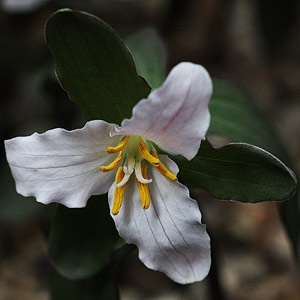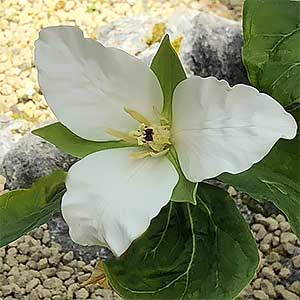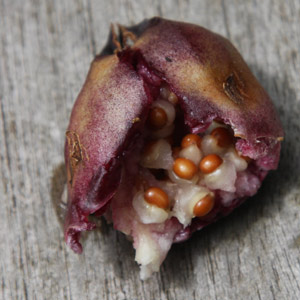
A much sought after plant, Trilliums are a shade loving woodland plant or ‘trillium wild flower’ also known as the ‘wake robin’, in the USA.
Many species are now grown commercially and are available for sale from online nurseries with flowers ranging from snow white to deep red. Trillium Grandiflorum and T. erectum are two favourite species.
With around 39 species of trillium plants and flowers they are a varied genus in form, size and color. Flower colours vary and include white, yellow, red and purple and lots of marked variations on these.

Trillium albidum is known as the ‘Giant White Wakerobin’ while Trillium ovatum is known as the Pacific trillium. The dwarf wake robin is the very pretty Trillium pusillum var pusillum is pictured right (also known as the Carolina Least Trillium).
When looking to buy Trillium Bulbs or plants, make sure that those offered for sale are grown in a nursery from seed, rather than removed from the wild. Wild trillium populations need protection.
Trillium Care
If we remember that trilliums are a woodland plant we can go a long way to providing suitable growing conditions. All trillium prefer a semi shaded position in rich moist but well drsined soil. Dig in lots of well rotted compost, rotted leaf litter etc.
Keep moist and be patient, Trillium can take a long time to flower.
Trillium are best left undisturbed. Well worth the effort and the wait.
Yes trilliums are a suitable plant to be grown in containers, the same conditions apply with a rich moist potting mixture and dappled shade being ideal. And yes they can be grown from seed as well. In less than ideal climates containers are a great way to control climate and sun for best results.
More information and problems
The good things about trilliums is that they have few problems, or so people who do not grow them will tell you. It is true that in the natural environment they will thrive, however in many cases we try to grow them in less than ideal conditions.
One of the problems with trilliums can be changing temperatures and this is particularly true of those on pots. When grown in the soil the natural insulation properties lower the extremes of temperature, both heat and cold.
A freeze in a container will almost certainly be fatal. You can fleece and protect, however that is only part of the problem.
Slugs and snails can be an issue with new shoots, foliage and flowers, so normal measures need to be taken. Deer and other animals will also eat them.
Fertilizer
The issue of fertiliser is a vexed one. We rely on mulch and a little aged manure for those in the ground, with the addition of some liquid fertilisers, seaweed, vermicaste and a little ‘Miracle Grow’.
We read a little about using slow release fertiliser every month, we choose to go a different path. We also dust with a little lime each autumn, seems to work.
Any compost or manure should be applied around the plants, not on top of them. The natural falling deciduous leaves can fall wherever they like with not problems.
In nature the fertiliser would be natural, compost, natural leaf mould, they grow well beneath deciduous trees with few problems.
Growing Trilliums in Containers
Pot culture is also more susceptible to pathogens, the natural microbes in the open ground make it easier to create a healthy environment.
However it is not always possible to grow in containers, so one solution is to use larger pots. They have better insulation properties simply because of the bulk of soil.
Poor soil in containers is another issue, trilliums need to be repotted every 2 – 3 years.
And a one fits all growing medium would be great to recommend, however this again will depend on climate.
In wet climates you may need a slightly more free draining mix than in dry areas. The addition of perlite can achieve this.
Trillium Varieties
- T. pusillum – Also known as ‘dwarf wake robin’, Ozark least trillium and least trillium are native across much of the southern part of the US from Oaklahoma to Nth Carolina. White flowers that look stunning in a shaded position.
- T. recurvatum – Relatively easy to grow with nice mottled foliage and deep red flowers .
- T. sulcatum – From Alabamba and N/E Virginia
- T. albidum – Known as the ‘ Giant White Wakerobin’ this one is native to California and nearby states.
- T. cuneatum – Are native to S/E USA, attractive marbled foliage with flowers ranging in color from red to, green, brown and yellow with erect petals.
Propagation

Pictured right we have a Trillium seed head, and yes you could collect them and grow them from seed.
Or you could even let them self seed in the garden.
The problem with propagation of Trillium from seed is that it takes so long from seed to flower. So if this is this is path you wish to go down, be patient.
The other propagation method is by division.
As Trilliums grow they do set offsets and eventually form clumps. These can be carefully dug and divided in Fall or even early spring.
Where to Buy
Readily available for sale from specialist growers.

